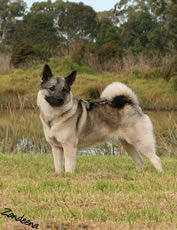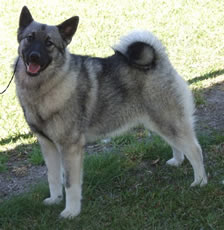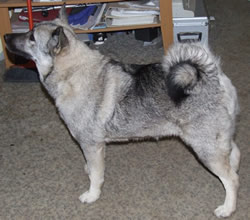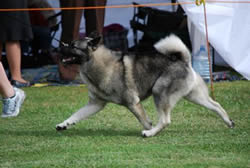Norwegian Elkhound
 Halgrove Hilda "Hannah" |
Photo with thanks to Kelly L McIntyre, www.halgroveelkhounds.net. |
Norwegian Elkhound
Breeders & Puppies For Sale If your
a Norwegian Elkhound breeder and have Norwegian Elkhound puppies for sale, send us your details for free and we will add to our Norwegian Elkhound Breeders page.
Norwegian Elkhound
Rescue Center Visit the Norwegian Elkhound rescue centers if your looking to rescue a Norwegian Elkhound, as well as learn more about the breed or just support the rescue centers for there hard work.
Group Hounds (KC)
Origin /
History The Norwegian Elkhound is an ancient breed of the spitz family and the National Dog of Norway. It was originally bred for hunting big game such as moose and elk, hence its name (‘elg’ is Norsk for moose). Over the years, the elkhound has also been trained to hunt badgers, rabbits, and other small game. It has also learned guarding, sledding, herding, and a range of other outdoor tasks, making it a favorite among working-class Scandinavians of the time.
Records show that Norwegian elkhounds have existed some 6,000 years ago, making it one of the world’s oldest dog breeds. It was only in 1923, however, that the breed was officially recognized by the British Kennel Club. Today, the Norwegian Elkhound is one of the most popular breeds in Europe and is gaining ground in American breeding circles as well.
Appearance The Norwegian elkhound resembles a classic spitz with its wedge-shaped head, curled tail, and most notably its pricked-up ears, which are set high and noticeably mobile. The ribcage dominates most of its body, making it appear short relative to its height. The small, thickly padded paws allow it to walk long distances without tiring.
Colours The preferred dominant color is medium gray, although coats a few shades lighter or darker are acceptable. The muzzle, ears, and tip of the tail are black. Light silver is allowed on the undercoat, stomach, legs, buttocks, and the bottom half of the tail.
Temperament These dogs are very affectionate with their owners and make excellent family pets. Young pups are playful and friendly around children, but can be shy around strangers at first. Adults, on the other hand, are docile and prefer to snuggle up to people. Their protectiveness and fearless disposition also make them great guard dogs, although they may need to be trained for obedience.
Height and
Weight 48 - 53 cm in height and 19.5 to 23Kg in weight. Males are females are usualy the same size.
Common Health
Problems Hip dysplasia, skin problems, and retinal disorders are some of the major health risks for this breed. Pups should be tested for retinal atrophy within the first few months to prevent complications. Also a common problem is Fanconi syndrome, a kidney disorder characterized by bone deformation and growth failure. Most of these conditions are hereditary, so it’s important to get a health certificate when buying pups.
Living Conditions The Norwegian Elkhound can tolerate an apartment setting, but will thrive best in a home with a large fenced yard. It needs enough space to walk and stretch during the day. It is fairly active indoors, so there should be enough space inside the house for occasional game play. These dogs are accustomed to the cold climate of the Arctic, so owners should take extra effort to keep them cool.
Exercise
Requirements Elkhounds are very energetic and need a lot of exercise to stay in top form. Daily brisk walks or jogs are encouraged. They’ll also enjoy running alongside bicycles, chasing other pets, and playing vigorous games with children. When outdoors, they should be kept on a leash, as they tend to wander off when they pick up strong scents.
Training Requirements Obedience training is recommended for this breed, as they can grow stubborn and aloof with age. Training should start in the first few months and continue into early adulthood, especially if they will be used as working dogs. Gentle and fair training works best, as harsh methods can greatly hurt the dogs’ feelings. Some dogs also become aggressive in response to physical punishment.
Life Expectancy Elkhounds live an average of 12 to 15 years.
Grooming The elkhound’s coat is naturally coarse and should not be over-groomed. Weekly brushing should be sufficient, except during shedding season when dead hairs tend to cling to the body. When the dog sheds, comb loose hairs free with a double-row metal brush.
Famous Examples
CompleteDogsGuide Comment An active working breed which needs plenty of exercise with its owners. Not ideally suited to town lifem or the ultra house proud, as this dog moults hair around th house quite a bit.
Breeders
Comments: Send us yours comments, advice for owners, potential owners etc.
Owners Comments: Send us any of your comments. Thanks in advance.
More Norwegian Elkhound Information: Check out our Norwegian Elkhound Clubs and links to more informative websites dedicated to the breed.
Submit your Norwegian Elkhound pictures Send us any pics of your Norwegian Elkhound, let us know there name and age and any other details. We'll add to this page. Contact us
| Norwegian Elkhound Photos |

Kahuti Little Adele "Adele" |

Halgrove Emerald "Emma" |
Photos with thanks to Kelly L McIntyre, www.halgroveelkhounds.net. |

Maya |

Jarluit Luka |
|

Cheeky |
|
Photos with thanks to Bronwyn. |
|